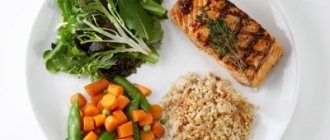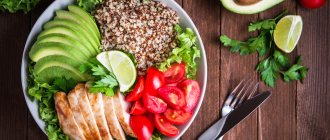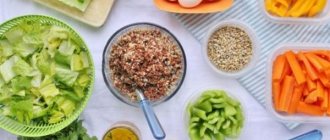Do you want to prevent all diseases in your life? Or are you suffering from any disease and want to get rid of it naturally and without any medicine? If yes, then this Ayurvedic diet plan can help you prevent and get rid of all diseases.
Definition: A diet prescribed by Ayurveda that can help you live a happier, healthier and longer life is called Ayurvedic diet. A meal plan according to Ayurvedic principles is known as an Ayurvedic meal plan.
This meal plan is suitable for everyone. Anyone can follow this Ayurvedic nutrition plan to achieve their health goals or stay happier and healthier forever and live longer.
Basic concept of nutrition in Ayurveda
The basic rules of this teaching are as follows:
- Nutrition is prepared taking into account the dosha of a particular representative of the fair sex.
- It is recommended to eat foods that increase feminine energy.
- You need to eat only when you feel hungry. It is strictly forbidden to overeat.
- You need to avoid stress and try to remain calm in any situation.
And also much attention in the teachings of Ayurveda is paid to the daily routine. It is important to rest for at least 8 hours and wake up with the sunrise.
Primary elements, doshas, gunas for women
Reality is formed by 5 elements, which have a huge impact on the processes occurring within and around a person. And these include:
| Peculiarities | Balance | Excess | Flaw | |
| Ether | This thin and cold element fills all the voids in the body | When the ether is balanced, a person becomes flexible and quickly adapts to any changes. | Those suffering from an excess of the element feel detached from reality. | Those who lack ether become stubborn and tense |
| Air | The main element that promotes blood circulation, digestion, and thinking. It helps you move and breathe. | When the air is balanced, a person achieves his goals, feels inspired and enthusiastic, and has increased performance. | Too much air makes people hypersensitive | The lack of an element manifests itself in slowness and a passive attitude towards everything around you. |
| Fire | The main energy generator in the body | A person with a balance element is active and full of enthusiasm and compassion. He knows how to enjoy life and is ready to change the world. | Manifests itself in irritability and constant outbursts of anger. Such a person is not able to concentrate on one task for a long time. | A lack of fire is manifested by slow metabolism, poor digestion, laziness and a passive mood. |
| Water | The substance lubricates, moisturizes, softens and cools | Increases resistance to stress, gives activity and excellent physical fitness | Promotes obesity and the formation of edema, impairs digestion, and reduces performance. | With a lack of water, constipation often occurs and reproductive function deteriorates. A person loses weight quickly. |
| Earth | Heavy, rough, immovable element | Increases self-confidence, determination and persuasiveness. The balance of the element promotes rapid career growth. | It manifests itself as constant anxiety, panic over little things, and lack of faith in one’s own strength. | With a lack of land, a person becomes sad, restless and boring. Digestive problems often occur. |
Doshi
Doshas are the biological principles that are formed at the moment of conception, at the time when the soul moves into the fetus. They also consist of the elements, and largely depend on heredity, the nature of the parents and their habits, as well as the rules of nutrition in the family.
There are 3 types of doshas in total, and they are present in the body of every person, but distributed in different proportions:
- Vata (air/ether). Women in whom this type of dosha predominates are distinguished by tall stature, asthenic physique, dry skin and weak hair. They rarely gain weight and have virtually no fat tissue. They have dark skin color that takes well to tanning. Eye color is, in most cases, brown.
- Pitta (fire/water). Representatives of the fair sex with a predominance of this dosha can boast of average height and build. At a young age, they, as a rule, do not gain excess weight, and even after 39 they do not gain much weight. Such women have little fat tissue, but it is enough to give the figure an attractive shape. The hair is usually light and oily, and the skin is sensitive and prone to acne. Eye colors are blue, green and gray.
- Kapha (earth/water). Women with this type have a harmonious physique, but they tend to be overweight and can quickly gain weight if they eat improperly. They have excellent, slightly oily skin and shiny hair. The complexion is light, and the eyes are most often brown.
Gunas
Ayurveda (nutrition for women) includes such a concept as gunas. This is the name given to the influence of the creator on the character of people, food, work, science, and indeed on the entire material nature.
Ayurveda is nutrition for women that helps increase energy levels, normalize all processes in the body and achieve harmony in all aspects of life.
Just like doshas, they are inherent in all people, but they predominate in different proportions in everyone:
- Sattva or the guna of goodness. It signifies purity and insight, and its predominance fills a person with a feeling of happiness and joy. But sattva’s diet includes natural and fresh foods, such as nuts, fruits and vegetables, and milk. Such food is easily digestible, quickly digested and helps to get rid of excess weight.
- Tamas or the guna of ignorance. Identifies false knowledge and collapse. This guna becomes a source of anger, violence, and people in whom it predominates will never be happy. In food, tamas refers to foods that have been chemically processed or grown with fertilizers. This guna also includes all canned foods, semi-finished products, alcohol, fish, meat and eggs.
- Raja or guna of passion. Active guna, identified with movement and excitement. It is she who causes excitement, all vain desires and ambitions. Under the influence of Raja, a person will not be happy for long, because having achieved something, he will begin to look for a new goal. In food, this guna includes fried and spicy foods, sweets, tea, coffee and alcohol.
Think and lose weight
Eating right is not the only thing you need to learn in the process of losing weight. Ayurveda teaches not only how to eat correctly, but also how to think correctly in order to bring harmony to the body and get rid of imbalances . Physical perfection is possible only when spiritual balance is achieved.
The causes of excess weight can be not only diseases of the body, but also a lack of joy and positivity in life, uninteresting work and daily stress. Fortunately, this is fixable. Your thoughts should bring goodness, purity, love for yourself and others. Then whatever you do will be for your good.
This diet is actually very simple. You just need to eat right and think right. Try to find something you like, it could be yoga and meditation, or it could be dancing, drawing, singing...
Determination of personality constitution according to Ayurveda. What should representatives of different doshas eat?
According to Ayurveda, each woman has her own metabolic level, which depends on the dosha that predominates in the fairer sex. And you need to leave the diet taking into account this particular feature.
Women – Vata
This dosha is a cold energy, so it needs to be “warmed up” with hot, easily digestible foods.
Dietary rules for Vata:
- You need to eat hot and high-calorie foods, generously sprinkled with oil. It is advisable to reduce the amount of cold dishes.
- The menu should include aromatic spices.
- You need to eat regularly and at the same time. You should avoid snacks and fast food.
- It is healthy to eat porridge, stewed vegetables, fermented milk products and whole grain bread.
- To relieve tension, you need to drink herbal teas.
Women with vata type need to fast for no more than a day. During this time, it is important to drink warm water and grape juice.
Woman – Pita
Women with a predominance of this type of dosha have a fast metabolism.
And they should adhere to the following dietary rules:
- It is better to eat lean dishes without adding spices.
- The menu should include fermented milk products and grain porridges.
- You can only eat fried and fatty foods with vegetables.
- It is better to give up tea and coffee and replace them with cold drinks.
Pete's women also shouldn't have late dinners. Alternatively, they can drink milk and butter at this time.
Woman – Kapha
Owners of this type of dosha should adhere to the following rules:
- It is advisable to eat hot and dry food. You should avoid sweet, spicy and sour foods.
- Each meal should include a bitter product, as well as beans and fruits.
- It is better to cook food on the grill or in the oven, but boiled and stewed foods should be avoided.
- In winter, you should lean on vegetables and herbs.
For breakfast, it is better for Kapha women to eat a little dark chocolate without sugar, or, in general, get by with a glass of warm water.
Impact of food on humans by type
Ayurveda also divides food into types depending on the guna (quality) it stimulates:
Rajasic (enhancing Rajas) is sour, spicy, salty food. It can “ignite” activity, encourage action, and increase passion. If you are planning some kind of event where you need strength to persistently achieve a goal, then you should eat just such food.
Tamasic food (inducing Tamas) is stale heated food, fast food, canned food. Such food makes a person apathetic, slow, and lazy.
Sattvic food (activating Sattva) - it is good to consume it before the need to perform heavy mental work. It improves mood and overall well-being. Such foods include light and sweet foods, honey, and milk.
Signs of poor digestion and habits to avoid
According to teaching, there are several eating habits that destroy the digestive process.
These include:
- It's a habit to eat when you don't feel like it. It is better to skip lunch or dinner than to eat something when you are not hungry.
- Drink with food. Freshly squeezed juices are only useful when they are consumed as an independent dish.
- Overeating or undereating. To achieve harmony, you need to observe moderation in everything.
- Eating incompatible foods.
- The habit of snacking on unhealthy foods.
What can't you eat?
Meat, fish and eggs are the main foods that should be excluded when switching to an Ayurvedic diet. Although there is no clear ban on them in Vedic cuisine. You may even come across a recommendation to drink meat with wine so that it is easier to digest.
However, the Vedas warn: animal food leads a person to degradation. The fact is that any food carries information about its origin; accordingly, the flesh of killed animals is literally permeated with the energy of suffering and violence. Anyone who uses it regularly will never achieve harmony.
Products to increase feminine (lunar) energy
The moon has a strong influence on the life of the fair half of humanity, and the attractiveness, state of mind and soul and health of every woman depend on the energy of the night luminary. And there are several foods that increase lunar energy, promoting material and spiritual well-being.
These include:
- Milk. The product awakens the hidden resources of the mind, helps to gain strength, and normalizes sleep. But for milk to bring maximum benefits, you need to drink it either in the morning or in the evening (no later than 18:00). Moreover, when taking it early, it is advisable to boil it and mix it with honey and spices. And in the evening it is better to add sugar and cardamom to milk.
- Raisin. It is better to eat dried fruits in the morning, then they fill the body with fresh strength.
- Bananas. They have a strong impact on a woman’s energy and give optimism, satisfaction with life and a feeling of joy.
- Pears. These fruits enhance strong-willed qualities and are needed by women in leadership positions.
- Raspberries. Berries normalize the level of acid in the stomach, and they should be added to the menu for women with Pitta type. But you need to eat raspberries either fresh or after drying them in the sun.
- Honey. This product should be consumed by all women, because, according to Hindus, it represents love. But in order for honey to bring maximum benefits, you need to choose the variety that suits you. To do this, you should smell it, and the suitable product will have a fresh, not sweet aroma.
- Plums. The fruits help normalize the functioning of the cardiovascular system, and are especially useful in cases of pressure changes.
Ayurvedic principles for good digestion
Food must be well chewed and digested so that the digestive system does not become disrupted. In Ayurveda, the fire of Agni, “sitting” in the stomach and small intestine, is responsible for this. It needs to be constantly supported. It can go off due to overeating, poor food combinations, or too much toxic substances in the body, known as ama. They, according to Ayurveda, cover the gastrointestinal tract and tongue, settle on tissues and form a breeding ground for chronic diseases.
Unlike conventional medicine, followers of Ayurveda believe that regardless of a healthy lifestyle, harmful toxins (ama) still accumulate in the body, which cause most diseases. Therefore, the ancient teaching advocates procedures for cleansing the mind and body. Ayurvedic nutritional and cleansing practices are among the simplest and most popular in the world. According to the writings of Rishis, the effectiveness of Ayurvedic procedures and nutritional principles will depend on the correct definition of the dosha.
Vedic cuisine is not just a collection of historically established culinary traditions. This is a carefully thought out diet that fully corresponds to the worldview system set out in the Vedas. Let's consider the basic principles of such nutrition.
Vegetarianism
Only vegetarian food is considered “pure” and healthy; it makes the body healthy and the mind calm. And if “pure” food gives rise to bright thoughts and aspirations in a person, then “unclean” food, on the contrary, leads him to destructive emotions and unkind desires. It is unclean food that is considered in Ayurveda to be the main cause of all diseases.
The main thing that characterizes Vedic cuisine and sets it apart from other culinary traditions is its special attitude to the cooking process. The ancient Aryans believed that the only purpose of human life is to serve God, and cooking is one of the forms of this service. A person in the kitchen should be as focused as possible, but at the same time his thoughts should be bright. Negative emotions are not allowed during cooking, otherwise the food will absorb them like poison.
Spices
Another important component of Ayurvedic cuisine are spices. A huge number of different spices and herbs used in cooking are designed to make food varied and flavors rich. The taste of food is very important: followers of Ayurveda often say that a person does not eat food, but absorbs tastes.
Ayurveda identifies 6 main flavors: sour, sweet, bitter, salty, spicy, astringent.
Another purpose of spices in Vedic cooking is disease prevention. Moreover, many of them have a healing effect and are designed to fight illnesses. Thus, during lunch a person not only consumes food, but also receives treatment.
Food prepared in a special way (that is, with prayers) and presented to God is called “prasad”. It is believed to have the best nutritional and beneficial qualities, and of course, the most magnificent taste.
According to Vedic tradition, prasadam has other amazing properties:
- He is able to purify a person on all levels - both physical and spiritual;
- Neutralizes part of negative karma;
- This food gives you a feeling of harmony with your body and mind;
- Helps spiritual growth.
In a word, prasadam is food not only for the body, but also for the soul. Therefore, followers of the Vedas believe that prasadam gives a person much more than simple food. It is customary to treat everyone with a divine gift - in this way people share divine food and joy with others.
Healing properties of spices
When creating a menu for women, we must not forget about spices, because they have medicinal properties.
And the following spices and seasonings are especially useful:
- Asafoetida. Relieves headaches and calms the nervous system, especially useful for problems with the spine.
- Ginger. Improves blood circulation and helps prevent colds. Ginger also normalizes the functioning of the thyroid gland.
- Turmeric. It is useful for diseases of the liver, kidneys and ulcers. It also helps fight allergies and improves body tone.
- Chilli. Eliminates digestive problems and helps in the fight against asthma, hepatitis and atherosclerosis.
- Cardamom. It has an antispasmodic effect, relieves pain, and treats ischemia and bronchitis.
- Celery. Quickly relieves spasms, and helps with blockage of the liver and spleen, as well as pleurisy.
It is also useful to include sesame in the menu, which improves the condition of bones and teeth. It is also worth consuming fennel, because it helps cure myopia.
Good time to eat food
Ayurveda is a set of nutritional norms that concern not only the choice of foods, but also the time when they should be consumed. And these rules should be followed by all women who want not only to lose weight, but also improve their health.
Breakfast
Breakfast should be served from 6:00 to 8:00, and it is important to start the day with the right foods. These include juicy fruits, milk or kefir. In addition, women should definitely consume sweets, for example, dried fruits or raw food candies, which normalize hormonal levels. You can also eat buckwheat porridge, but you should forget about buns, cakes and cookies forever.
Dinner
The ideal time for this meal is between 11:00 and 14:00. During this period, the digestive system is fueled by solar energy, so that it works as actively as possible. For lunch, it is advisable to eat cereal porridge or beans, fried vegetables in oil.
Dinner
According to Hindus, dinner is an important meal on which the functioning of the digestive system depends. It should be held from 16:00 to 18:00. But for dinner it is advisable to eat stewed vegetables, with the exception of potatoes, nuts and heated milk. Such products will relax the body and help it prepare for a night's rest.
Ayurveda food that can adjust the internal balance of energies
Ayurveda believes that food can adjust the internal balance of energies, which will keep the body healthy. However, man has turned his back on nature and today perceives food as a means to satisfy desires. For some, food is a passion; for others, it is a way to relieve anxiety or escape from problems.
All the collected knowledge about how to eat is in Ayurvedic knowledge. This is a science that tells how to live in a physical body and how to properly consume food so that it is beneficial and not harmful.
Principles of Ayurvedic nutrition for weight loss
Ayurveda - nutrition for women that helps to lose weight. But to achieve this goal, you will need to adhere to the basic rules of teaching.
Daily regime
According to ancient teachings, you need to wake up and go to bed to rest with the sun. Waking up at 5:00-6:00 is not a problem for most, but going to bed in winter at 4-5 pm in modern realities is difficult. However, you should go to bed at 22:00-23:00. Then, with 7-8 hours of sleep, the body will have time to rest and gain strength for the new day.
Diet
According to the rules of Ayurveda, you need to eat 3 times a day. Moreover, most of the daily requirement (51%) should occur at lunch. The rest of the diet should be divided equally between breakfast and dinner, but it is advisable to eat low-calorie foods at the last meal.
Naturalness
To lose weight according to Ayurveda, you need to eat the most natural foods possible. And it is advisable to give preference to local vegetables and fruits, that is, they should be grown in the region where the fairer sex lives.
It’s also worth adding seasonal products to the menu that ripen at this time of year. But in winter and early spring, when nothing grows, you can diversify your diet with beets, carrots, cabbage and other shelf-stable vegetables.
Six flavors
All products have their own specific taste, which also consists of elements. There are 6 of them and they affect the doshas differently:
| Taste | What elements does it consist of? | Peculiarities | Effect on doshas | Products |
| Sweet | Earth/Water | Promotes tissue regeneration, soothes and cools | Taste weakens Pitta and Vata, but strengthens Kapha | Whole grains (wheat and rice), sweet fruits, vegetables (carrots, beets), milk and butter, herbs |
| Sour | Earth/Fire | Warms, thins blood, improves digestion | Strengthens Pitta and Kapha, and reduces Vata | Lactic acid products, citruses and plums, vinegar, cloves and cumin |
| Salty | Water/Fire | Reduces pain, relieves constipation, and thins the blood. Excess may worsen skin condition. | Reduces the influence of Vata, and increases Pitta and Kapha | All types of salt, seaweed and seaweed |
| Spicy | Fire/Air | Has a bacterial effect, increases appetite and brain activity | Strengthens Pitta and Vata, and reduces the influence of Kapha | Garlic, onion, ginger, all types of pepper, mustard and asafoetida |
| Bitter | Air/Water | The most useful for treatment, as it has a bactericidal and antipyretic effect. This taste also cleanses the blood and removes toxins. | Weakens the forces of Pita and Kapha, and increases the influence of Vata | Bitter-tasting foods include turmeric, rhubarb and dandelion root, spinach, lettuce and milk thistle. |
| Astringent | Air/Ground | Thickens the blood, helps fight diarrhea and reduces sweating | Strengthens Vata, balances Pitta and Kapha | Apples, bananas, broccoli, all types of cabbage, carrots, legumes, rye, basil, dill, fennel |
Product combination
To balance your diet according to Ayurveda, it is important to consume all 6 flavors at every meal. But they should be eaten in a certain order. So, you need to start with heavy, fatty and cooling dishes with a sweet taste. Then you should eat salty and sour foods. And it is advisable to end the meal with light and warming dishes with a spicy, bitter and warming taste.
The principle of "six tastes"
Ayurveda distinguishes six basic tastes that all foods have.
- Sweet taste is present in foods such as rice, milk, sugar, wheat, honey, dried fruits, buckwheat, carrots, beets, pears, grapes, potatoes, onions, some berries, melon. They provide a quick release of energy, producing an invigorating effect. Sweet-tasting foods stimulate the production of serotonin, which gives you a feeling of pleasure. However, it is important to know that foods with a sweet taste contribute to obesity, poor digestion, fermentation in the intestines and the onset of diabetes. For people prone to Kapha, it is best to completely exclude them from the diet or consume them little by little in the morning.
- Most berries, citrus fruits, fermented milk products, rhubarb, tomatoes, pineapples, papaya and vinegar have a sour taste. If used wisely, they effectively improve digestion and give vigor and energy. Excessive consumption can cause increased appetite, heartburn and stomach ulcers.
- The salty taste is characteristic of meat, salt, seaweed, soy sauce, and miso paste. Moderate consumption of salty foods maintains and restores a healthy water-salt balance in the body, improves digestion and absorption of food. An excess of salty foods leads to edema, additional stress on the kidneys, increased appetite, deterioration of blood circulation and skin condition.
- We feel the spicy taste in a variety of red peppers, ginger, wild garlic, onions, garlic, mustard, and radishes. This taste warms very well, stimulates salivation and appetite, improves digestion and blood circulation. In addition, the spicy taste serves as an excellent prevention and treatment of colds and inflammatory diseases. However, spicy foods should be consumed with caution, as they can cause nervous excitement, heartburn, ulcers, indigestion, and even decreased reproductive function.
- A bitter taste is inherent in almost all medicinal herbs, as well as aloe, dandelion, coffee, sorrel, turmeric and sandalwood. Most often, the bitter taste is not consumed as food, but a variety of medicinal teas are prepared with it. With its help, you can effectively reduce high body temperature, improve the flow of bile and liver function, treat bacterial diseases and remove toxins from the body. Since no one will be able to consume too much bitter food or drinks, do not limit yourself to it. Various medicinal herbal teas can be drunk every day throughout the day.
- All legumes, cauliflower, celery root, green beans, artichokes, pumpkin, lettuce, pomegranate and bananas have an astringent taste. Products that have an astringent taste perfectly saturate, stop bleeding, heal ulcerative damage to the mucous membrane and skin, and also give the body vigor. Excessive consumption can cause flatulence and constipation.
It is very important that food contains a balance of these tastes, depending on the person’s constitution. By following the simple rule of balancing tastes, you can forever get rid of excess weight and health problems without diets or restrictions.
All food should contain these tastes, however, to correct health or figure problems, their content in the diet can be varied. Source: wowdiets.ru
Sample menu for the week
| Kapha | cotton wool | Pitta | |
| Breakfast | Fruit salad, smoothie or stewed apples. If you feel very hungry, you can eat oatmeal or wheat porridge with dried fruits and honey. | Hot rice, wheat or oatmeal porridge. You can drink warm milk with sugar or honey. You should not start the day with fried or flour dishes. | The best breakfast would be porridge made from oatmeal or other whole grain cereals, cooked with milk or ghee. You can also eat seasonal vegetables and drink masala tea. |
| Dinner | It is worth eating a large portion of stewed or fried vegetables with beans, or lentil soup. You can also add broccoli, carrots and cornbread. | This meal should include vegetable salad, sweet potatoes and white meat. It is also worth adding beans and a little lemon. | For lunch, you can eat legume and vegetable curry, baked potatoes or boiled basmati rice. It is advisable to sprinkle any dish with lemon juice. |
| Dinner | The portion should be half as much as for lunch. It is advisable to eat vegetable soup with beans and suitable spices at this meal. | It is worth giving preference to dishes made from beans, but to prevent them from increasing gas formation, it is advisable to add spices to the delicacy (coriander, cumin, garlic). | For dinner, you should eat seasonal vegetables, rice dishes with tofu, and green beans. |
Recipes for Ayurvedic dishes and drinks
Ayurveda is nutrition for women, which contains many healthy dishes suitable for any dosha. And they should be added to the menu for all those who want to adhere to this philosophy.
Lassi
A popular drink in India can be prepared from the following set of products:
- yogurt – 100 ml;
- water – 100 ml;
- rose water (optional) -1 tsp;
- sugar – 8 g;
- cardamom – ¼ tsp.
Preparation:
- Having opened the cardamom boxes, you need to remove the seeds from them and crush them in a mortar.
- Then the spices need to be combined with the rest of the ingredients and beat with a mixer until a thick foam appears.
Milk drink
A drink prepared according to the following recipe evens out the level of Vata and Pitta dosha.
And to create it you will need the following products:
- milk – 200 ml;
- water – 50 ml;
- cardamom – ¼ tsp;
- young almonds – ¼ tsp.
Preparation:
- The seeds must be crushed in a mortar and then combined with the rest of the ingredients.
- The resulting liquid should be placed over medium heat and brought to a boil.
- Then the drink must be boiled until 100 ml remains.
Lentil soup
This dish is balanced and suitable for all doshas.
And for its preparation you will need to prepare the following products:
- red lentils – 200 g;
- carrots – 100 g;
- celery – 100 g;
- water – 2 l;
- vegetable oil – 30 ml;
- tomatoes canned in their own juice – 400 g;
- bay leaf – 2 pcs.;
- greens – 30 g;
- a pinch of salt, asafoetida, black pepper, turmeric, paprika and oregano.
Preparation:
- Carrots and celery must be washed and cut into small pieces.
- Heat the oil in a frying pan and fry the spices in it for 1-2 minutes, and then add the vegetables to them.
- The mixture must be cooked over medium heat until golden brown.
- To the vegetables you need to add lentils, water and bay leaf.
- The mixture must be boiled, covering the container with a lid, for 10 minutes.
- Then you need to add tomatoes to the soup and boil all the ingredients for another 20 minutes.
- At the end, the dish should be sprinkled with chopped herbs.
Rice porrige
To prepare this dish you will need to stock up on the following products:
- basmati rice – 180 g;
- ghee – 1 tbsp. l.;
- cumin seeds – 2 g;
- salt – 4 g;
- water – 800 ml.
Preparation:
- Rice should be washed thoroughly.
- Place a thick-walled pan over medium flame and heat in ghee and cumin seeds for 1 minute.
- You need to add rice to the mixture, and stirring thoroughly, you need to sauté the cereal for about 60 seconds.
- Then you need to fill it with water and add salt.
- Next, you need to bring the mixture to a boil and boil for 2-3 minutes.
- Then cover the container with a lid and reduce the heat to low.
- It will take about 15-20 minutes to cook the cereal.
Tofu with spices
To prepare an Ayurvedic dish, you will need to prepare the following set of products:
- firm tofu – 500g;
- gzhi – 100 ml;
- cumin seeds – 1 tsp;
- mustard seeds (black) – 1 tsp;
- asafoetida – 1 g;
- clove of garlic – 1 pc.;
- chili pepper (green) – 1 pc.;
- cilantro – 15 g;
- onions – 0.5 pcs.;
- turmeric – 1 g.
Preparation:
- Place the frying pan on a medium flame, heat the ghee in it, and then add asafoetida, cumin and mustard seeds to it.
- Fry the mixture until it begins to crackle.
- Then you need to add chopped onions and garlic, chopped herbs, and turmeric to the mass.
- It will take about 6-7 minutes to cook the ingredients, and then add the crumbled tofu into them.
- While stirring, you need to fry the mass for 1-2 minutes, and then you should cover the pan with a lid, and turning off the heat, leave the dish to simmer for another 10 minutes.
Ayurvedic nutrition will help normalize weight for any woman. But this ancient philosophy will also improve health and tone the body. But for this you need to adhere to the basic rules of teaching.
What are doshas and balance?
Ayurvedic texts explain that the basic elements in the human body are combined into three main vital forces . They are called doshas. Only the person in whose body these doshas are in balance can be truly healthy.
Doshi
The doshas are called vata, pitta, kapha:
- Cotton wool. Balancing this dosha organizes proper nutrition, intellectual activity, deep sleep, and good mood. If you have an imbalance in this part, then you will recognize it by rough and dry skin, constipation, insomnia, weight instability, and anger.
- Pitta. Balancing means normal body temperature, healthy digestion, good appearance, sharp mind. When imbalanced, a rash appears on the body, heartburn, hair loss, vision problems, and obesity appear.
- Kapha. Balancing leads to muscular strength, high immune defense, courage, generosity, mental peace. When out of balance, you have oily skin, clogged veins, slow digestion, heavy weight, and lethargy.
When one of these substances dominates, the balance is disturbed, causing the person to fall ill. Considerable attention is paid to nutrition. It depends on it how harmoniously the doshas coexist with each other. If you improve your nutrition, you can restore your ideal balance.
At the same time, Ayurvedic nutrition for weight loss does not detract from the merits of other practices - it is perfectly combined with cleansing, massage, physical activity, a positive attitude and regularization of the daily routine. It is easy to conclude: even in Ancient India they understood that the health of the body and good weight depend on a set of actions.











